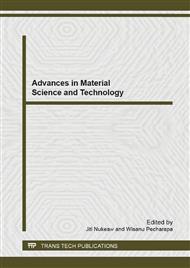[1]
P. Bergveld, Development of an ion-sensitive solid-state device for neurophysiological measurements, IEEE T. Bio-med. Eng. 17 (1970) 70–71.
DOI: 10.1109/tbme.1970.4502688
Google Scholar
[2]
J.-L. Chiang, J.-C. Chou and Y.-C. Chen, Sensitivity and Hysteresis Properties of a-WO3, Ta2O5, and a-Si:H Gate Ion-sensitive Field-effect Transistors, Opt. Eng. 41(8) (2002) 2032–2038.
Google Scholar
[3]
J. C. Chou and Y. F. Wang, Study on the temperature dependence of the hysteresis for the a Si:H gate pH-ISFET, Mater. Chem. Phys. 70(1) (2001) 107–111.
Google Scholar
[4]
J.-C. Chou, C.-Y. Weng and H.-M. Tsai, Study on the temperature effects of Al2O3 gate pH-ISFET, Sensor Actuat. B-Chem. 81(2–3) (2002) 152–157.
DOI: 10.1016/s0925-4005(01)00945-5
Google Scholar
[5]
L.-T. Yin, J.-C. Chou, W.-Y. Chung, T.-P. Sun and S.-K. Hsiung, Characteristics of silicon nitride after O2 plasma surface treatment for pH-ISFET applications, IEEE T. Bio-med. Eng. 48(3) (2001) 340–344.
DOI: 10.1109/10.914797
Google Scholar
[6]
J. C. Chou and Y. F. Wang, Preparation and study on the drift and hysteresis properties of the tin oxide gate ISFET by the sol-gel method, Sensor. Actuat. B-Chem. 86(1) (2002) 58–62.
DOI: 10.1016/s0925-4005(02)00147-8
Google Scholar
[7]
M. Lahav, A. B. Kharitonov and I. Willner, Imprinting of Chiral Molecular Recognition Sites in Thin TiO2 Films Associated with Field-Effect Transistors: Novel Functionalized Devices for Chiroselective and Chirospecific Analyses, Chem-Eur. J. 7(18) (2001) 3992–3997.
DOI: 10.1002/1521-3765(20010917)7:18<3992::aid-chem3992>3.0.co;2-g
Google Scholar
[8]
J. van der spiegel, I. Lauks, P. Chan and D. Babic, The extended gate chemically sensitive field effect transistor as multi-species microprobe, Sensor Actuat. 4 (1983) 291–298.
DOI: 10.1016/0250-6874(83)85035-5
Google Scholar
[9]
J.-C. Chou and C.-W. Chen, Fabrication and Application of Ruthenium-Doped Titanium Dioxide Films as Electrode Material for Ion-Sensitive Extended-Gate FETs, IEEE Sens. J. 9(3) (2009) 277–284.
DOI: 10.1109/jsen.2008.2012221
Google Scholar
[10]
Y.-H. Liao and J.-C. Chou, Fabrication and Characterization of a Ruthenium Nitride Membrane for Electrochemical pH Sensors, Sensor 9(4) (2009) 2478–2490.
DOI: 10.3390/s90402478
Google Scholar
[11]
Y.-Q. Hou, D.-M. Zhuang, G. Zhang, M. Zhao, and M.-S. Wu, Influence of annealing temperature on the properties of titanium oxide thin film, Appl. Surf. Sci. 218(2003) 98–106.
DOI: 10.1016/s0169-4332(03)00569-5
Google Scholar
[12]
G. A. Battiston, R. Gerbasi, A. Gregori, M. Porchia, S. Cattarin and G. A. Rizzi, PECVD of amorphous TiO2 thin films: effect of growth temperature and plasma gas composition , Thin Solid Films. 371(1–2) (2000) 126–131.
DOI: 10.1016/s0040-6090(00)00998-6
Google Scholar
[13]
E. M. Guerra, G. R. Silva and M. Mulato, Extended gate field effect transistor using V2O5 xerogel sensing membrane by sol gel method, Solid State Sci. 11(2) (2009) 456–460.
DOI: 10.1016/j.solidstatesciences.2008.07.014
Google Scholar


